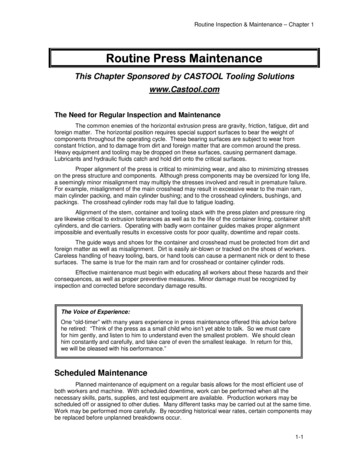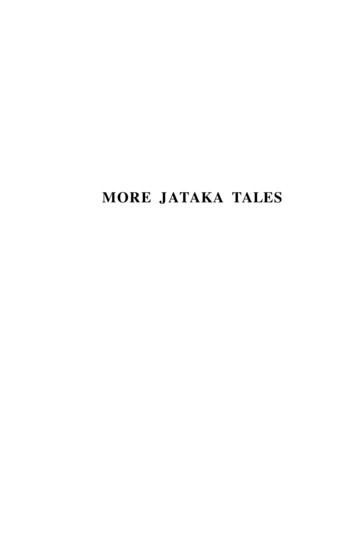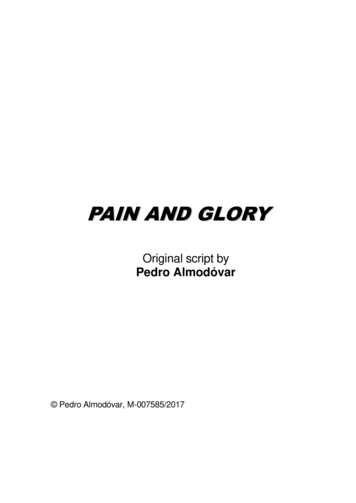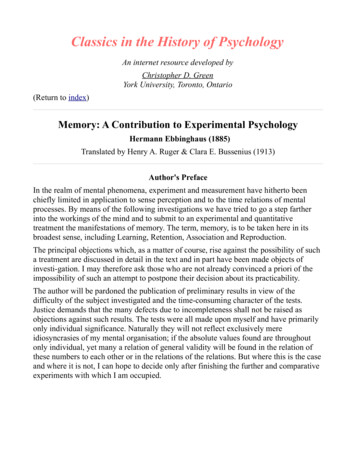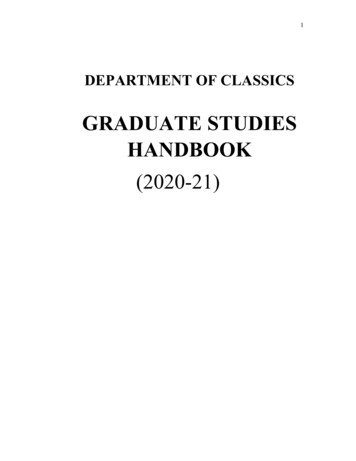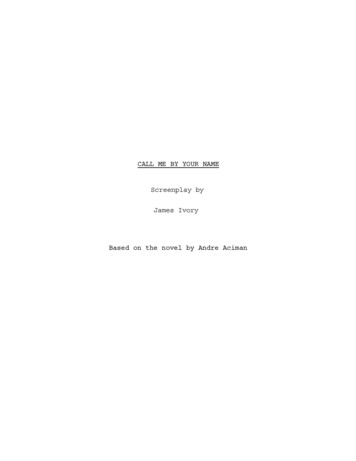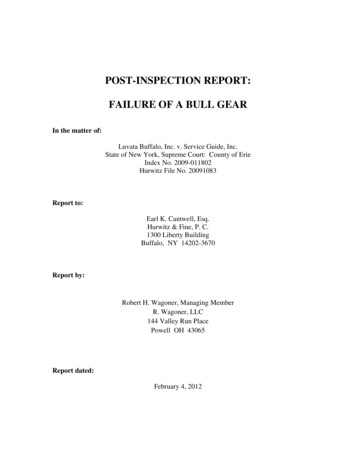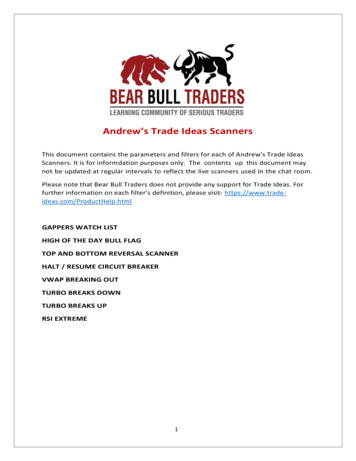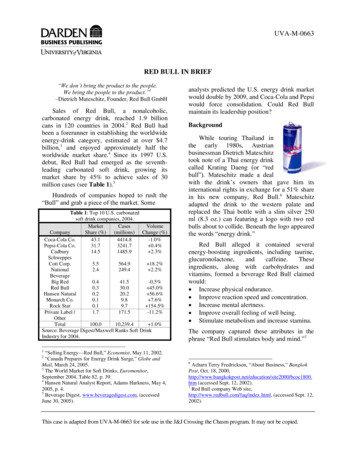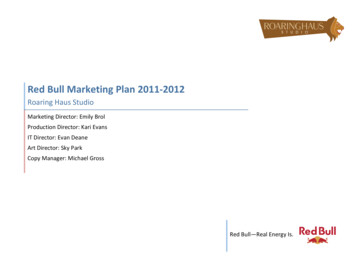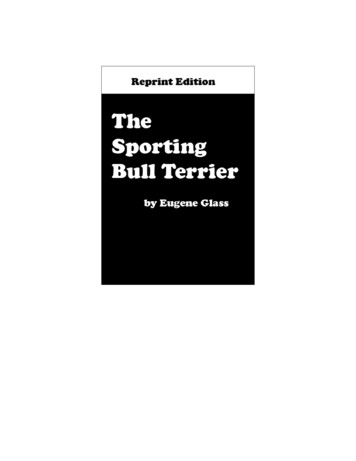
Transcription
2THE SPORTING BULL TERRIERThe Sporting Bull TerrierA Book of General InformationValuable to Owners, Trainers,Handlers, and Breedersof Bull TerriersBy EUGENE GLASSEditor ofTHE DOG FANCIERILLUSTRATEDPublished by "The Dog Fancier,"Battle Creek, Michigan, U. S. A.2
3THE SPORTING BULL TERRIERThis Reprint Ebook Version Is Published with an Original Cover Design and an OriginalForeward. Thus, in part is copyrighted 2004 by PIT BULL CLASSICS PRESS.Legal Disclaimer: Pit Bull Classics Press does not in any way condone animal cruelty orillegal activities. The books are all in the Public Domain and are reprinted for historicaland entertainment purposes only. Additionally, The training, pit fighting, breeding norany other methods or actions portrayed in this work do not reflect the beliefs of Pit BullClassics Press; however, we do support freedom of speech.This book offered by Pit Bull Classics Press is an eBook reproduction of the completeand original version of The Sporting Bull Terrier by Eugene Glass, originally publishedin 1914 and now in the public domain. This eBook edition published with an originalcover design and an original foreword, is not sponsored or endorsed by, or otherwiseaffiliated with, Eugene Glass or his family and heirs, or any other person or entity.3
4THE SPORTING BULL TERRIERCONTENTSHISTORICAL . 5THE STANDARDS. 8BREEDING AND CARE . 13TRAINING FOR THE PIT. 18THE TRAINING MACHINE. 25THE SPRING-POLE. 27TO CHAIN-BREAK A DOG. 28RULES OF THE DOG PIT . 30TRAINING FOR RAT-KILLING MATCHES . 36EAR-CROPPING . 39HINTS ON HANDLING IN THE PIT. 41DISEASES AND TREATMENT. 43THE CONSTRUCTION OF A KENNEL . 474
5THE SPORTING BULL TERRIERHISTORICALThe origin of the Pit Bull Terrier, sometimes called the Sporting BullTerrier, is similar to that of the English (bench show) Bull Terrier, both ofwhom are supposed to be the result of a cross of the old English Bulldogand the White English Terrier, with perhaps some Pointer thrown in, later.In the case of the bench show dog, it is necessary that it be pure white incolor; although it is seldom, even to this day, that each one in a litter frompure white parents is solid white. The brindle and black of the old Bulldogseems to linger and crop out unexpectedly in the offspring. Those withmarkings, not eligible to dog show honors, have from time to time beentrained to compete in rat-killing contests, and used for bear, badger andraccoon baiting, and also for contests in the pit. Although dog fighting isan illegal sport, hundreds of persons in all parts of the United States andCanada are at the present time very much interested in it. It has been apopular sport in the larger cities for a century; but for the past severalyears has been tabooed by the authorities and efforts are constantly madeto prevent or stop the contests. However, a well bred and game pit dog isconsidered a valuable asset, not only to the sporting fraternity, but to thefancier and breeder as well. Pit contests are becoming less frequent everyyear, owing to the punishment the dogs are liable to receive in the pit andwhich the humane individual wishes to avoid. But the fighting qualities ofthese dogs are usually dwelt upon when offering them for sale, more toappeal to the owner's, pride in the possession of a "good one" than for anyactual service in the pit that is expected of the dog. Many owners andbreeders of Pit Bull Terriers have an aversion to professional dog fighting,but never fail to extol the gameness in their dogs. This fighting quality is aprominent characteristic of the Bull Terrier, and an owner of one of thesedogs, whether it be of the pit or bench show type, knows that as acompanion and guard dog he has the best on earth, and when out for awalk, with his happy dog by his side, feels, and shows in his everyexpression and carriage, perfect confidence in the dog's ability to take careof itself, as far as any other dog is concerned Back of this is the reason somany breeders, in their advertisements in dog journals, enlarge upon thefighting qualities of their stock. Should occasion arise, through argumentor otherwise, for the possessor of one of these dogs to demonstrate orprove his dog's gameness in a contest, he wants to have the goods to do itwith, and the probabilities are he will buy from a breeder who advertisessuch stock. The advertiser must be able to back his claims for his clogs;hence the pit contests. These Bull Terriers with brindle and blackmarkings, which were forced into the pit dog class, have been bredheavier and more powerful in build than the bench show type, and in somecases receive a special training for pit purposes; hence, the Pit BullTerrier. However, notwithstanding the claims of many breeders of the pitvariety, he does not naturally possess one whit more gameness in hismake-up than does his pure white brother. Take two dogs of equal weight,one a strictly bench show type and the other a "dead game" fighting dog,5
6THE SPORTING BULL TERRIERand the chances are just as good that the show dog will win in a fight asthat the pit dog will, and in many cases his gameness is greatly superior tothat of the trained fighter, who perhaps loses in that respect by an outcrossor some fault in rearing or early training. The Bull Terrier, whether pit orbench show type, is an ideal dog as a companion, guardian, or vermindestroyer He possesses great powers of endurance, fearless courage and awonderful hardiness of constitution. These dogs make remarkably faithfuland reliable companions and watch dogs; they are exceedingly handsometo look at, of affectionate disposition, easily taught many useful andpleasing stunts, and delight in the extermination of all sorts ofobjectionable vermin. Referring to Bull Terriers in England, Mr. TheodoreMarples, a well known writer and editor of Our Dogs, says: "The mistyrecords and data of the origin of most breeds of dogs applies to a greatextent to the Bull Terrier, whose creation cannot be distinctly traced,but which was at least given an impetus when bull-baiting and dogfighting were made illegal pastimes in 1835. The appetite of the populace,and also the gentry—not forgetting the undergraduates of Oxford andCambridge—for a more vicious form of sport than obtained in these dayswas not, of course, extinguished with the abolition of bull baiting, whichsport was largely substituted by dog-fighting, badger-baiting, etc., theformer of which was, of course, carried on clandestinely. For thisdescription of sport a different type of dog was, of course, required to theBulldog,—viz., a dog with a longer and more punishing jaw, and moreagility, yet game and powerful. For this purpose the Bulldog was crossedwith the Terriers available in those days, which were more or less of anondescript pattern. This assumption is proved by the color and type of theearly Bull Terriers, which were either brindled or fallow-smut in color, —taking after the Bulldog—with strong and Terrier-like bodies and limbs,and heads of fair length and strength, but not the clean-cut long head ofthe modern Bull Terrier. Many of the colored Bull Terriers survive to thisday; and here I may mention that here is at this moment dawning on theBull Terrier horizon a distinct desire among admirers of colored dogs tobring the colored Bull Terriers, and more particularly the brindles, up tothe level and type of the whites, which, for half a century or more, haveheld undisputed sway in general public esteem and on the show bench.This is both a legitimate and laudable aspiration, for while I would not forone moment attempt to disparage the smart, clean looking whites, yet, inview of his origin, his avocation and tradition, it seems but logical thatthere should be brindle and fawn Bull Terriers as well as whites, brindlebeing a color that is always associated with hardihood, and which iscertainly handsome. The dog still retains his pugilistic propensities, whichare bred in him and inherent to his nature. He is the gamecock of thecanine species, and undoubtedly the finest exponent of the 'noble art' asapplied to dogs, which puritans would probably describe as the 'ignoble'art.6
7THE SPORTING BULL TERRIER7
8THE SPORTING BULL TERRIERTHE STANDARDSBelow we publish the standard and points of the bench show WhiteEnglish Bull Terrier, and also the standard of the Pit Bull Terrier; the onewhich was adopted by the Pit Bull Terrier Breeders' Association.We are reproducing a few illustrations of the best English Bull Terriers,for comparison with the pit dog type, many illustrations of the latter beinginterspersed, with brief descriptions of the subjects, throughout thesepages.THE BULL TERRIER STANDARD.As Approved By the Bull Terrier Club of America.Head.—Should be long, but with due regard first to type. Skull as nearlyflat as possible and widest between the ears. Viewed from above it shouldtaper gradually and merge into the muzzle without perceptible break in theline. There should be a slight indention down the middle, but without"stop" and with as little brow as possible Foreface filled right up to theeyes. Preferably the foreface should have a decided "downness " Eyes,very small, black, set high on the head, close together and obliquely Theyshould be either almond shaped or triangular, preferably the latter. Walleye is a disqualification Muzzle wide and tapering, but without so muchtaper as to make the nose appear pinched. Muzzle should be neithersquare nor snipey, but should present a rounded appearance as viewedfrom above. Nose broad, wholly black, and with wide open nostrils.Dudley or wholly flesh colored nose is a disqualification. Under jawstrong and well defined. Lips should meet closely and evenly all around,should not run too far back, and there should be an entire absence of"lippiness" Teeth sound, strong, clean, regular and meeting evenly. Anydeviation from this rule, such as "pig jaw," "undershot" or "overshot," is abad fault. Ears when standing erect should not cause noticeable wrinklingof the skin on the head. Ears should be cropped, should be straight and ofmoderate length. It is important that there be as little cheek as possible, butwhere it is present it should not be bunchy or prominent, but should mergegradually into the lines of the muzzle and neck.Neck.—Slightly arched, tapering from shoulders to head and free fromlooseness of skin.Shoulders.—Strong and muscular, but without any appearance ofheaviness or "loading " Shoulder blades wide, flat and sloping well back.Back.—Short, strong and muscular. Should be higher at withers than hips.There should be no slackness nor falling away behind the withers, butback should be slightly arched at loin, with loins well developed andslightly tucked. Ribs well sprung, close together and intercostal muscles8
9THE SPORTING BULL TERRIERwell developed; back ribs deep. Chest deep from withers to brisket andwide from front to back ribs, but should not be broad as a lewed facing thedog.Tail.—Short in proportion to the size of the dog, set on low, broad whereit joins the body and tapering to a point, should be straight and should notbe carried above the level of the back.Legs.—Should have big, round bone and strong, straight, upright pasternsThe whole foreleg should be reasonably straight, but without the stiltmessof the Fox Terrier Thighs somewhat long, with muscle well developed, butwithout "loading" Hocks short, fairly straight, well let down and shouldturn neither in nor out as viewed from behind.Feet.—Of the cat pattern, with toes short, well arched and close togetherPads strong and nails short.Coat.—Short, close, stiff to the touch, and with fine ough objection able, are not aWeight.—Is not a matter of importance, so long as the specimen istypical.Faults. —Light bone, round eyes, badly placed eyes , light eyes , domedskulls, butterfly noses , noticeable cheekiness, dished faces, lippiness,throatiness, teeth not meeting evenly, long or slack backs, long, thick or"gay" tails, loose shoulders, crooked elbows, loaded shoulders or thighs,weak pasterns, pig feet, toes turning either in or out, markings.PIT BULL TERRIER STANDARD.As Approved By the Pit Bull Terrier Breeders'Association.Head.—Of medium length, skull flat and widest at the ears, prominentcheeks and forehead free from wrinklesStop. —Well defined, indenture not too deep.Muzzle.—Square and wide as viewed from the front, presenting a roundappearance as viewed from above Under jaw strong and well definedLips.—Meet closely and evenly all around, not running too far back withan entire absence of any lippmessTeeth.—Clean, sound and strong, meeting evenly9
10THE SPORTING BULL TERRIERNose. —Black, nostrils wide and openNeck.—Slightly arched, tapering from shoulders to head, and free fromany looseness of skinShoulders.—Stron
By EUGENE GLASS Editor of THE DOG FANCIER. ILLUSTRATED. Published by "The Dog Fancier," Battle Creek, Michigan, U. S. A. 2. 3 THE SPORTING BULL TERRIER. This Reprint File Size: 2MBPage Count: 68

